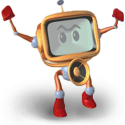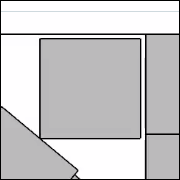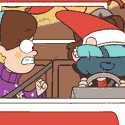|
eSports Chaebol posted:I think the Culture would win most sci-fi space battles, not even because of their technology sophistication or the scale of their ships, but simply because Banks took the notion of crazy sci-fi space battles to the logical conclusion of doing poo poo like teleporting singularities right into the middle of the enemy instead of having nice WW2 naval battles with pew-pew weapons in space. I suppose it would look boring on TV or film though, hence the fanciest thing you get is something like the Picard Maneuver. Entertainingly, the wh40k book Priests of Mars has both kinds.
|
|
|
|

|
| # ? May 14, 2024 23:38 |
|
The Culture wins every space battle ever because it's basically just "What if everything was the best and most awesome thing ever and it was Burning Man?" Then if you were lucky the battle between The Culture and Star Wars would be written almost exactly like Takkaryx's post unless some even shittier form of prosecraft could be found, such as a 4chan >greentext story.
|
|
|
|
Nostrum posted:A star destroyer would loving annihilate the Enterprise. The Enterprise has what, like 10 phaser banks and 200 torpedoes? Half the time their weapons don't even do poo poo. A Star Destroyer has like 2000 turbolaser batteries and 1500000 TIE fighters and ion cannons and like a million torpedoes. Also the laser bolts are actually super heated gas and you can estimate their payload from the asteroid scene in Empire and All of the numbers about Star Wars from the tech manuals were specifically chosen by the bitter nerd author so he could win Star Wars vs Star Trek arguments, it's why they're so absurd and, like, one ship turbolaser bolt could blow up America. The Culture would obviously win just about all fictional battles because the entire point of the setting is that the civilisation has reached a lazy supremacy, and the problems they now face are the questions can't be solved by pew-pew. Banks did know how to make a totally one-sided battle a fun read on the occasion he broke that out, though. MikeJF fucked around with this message at 08:19 on Dec 15, 2015 |
|
|
|
Tujague posted:The Culture wins every space battle ever because it's basically just "What if everything was the best and most awesome thing ever and it was Burning Man?" They don't though. Of the 8 or so books, there's really only one described equivitech brawl, and only a handful of other fights. The biggest war the culture was in was with an equivitech species, which they nearly lost, and big fights rarely happened unless you were defending a planet for some reason. Trek just doesn't portray capital engagements well, and that's OK, because they look good. DS9 had some amazing fleet engagements. What Banks does well is describe what a capital brawl feels like when AI are the ones driving. A culture fight would look terrible on TV, a whole lot of nothing then a bunch of pinpoints of light.
|
|
|
|
Takkaryx posted:The biggest war the culture was in was with an equivitech species, which they nearly lost, Ehhhhhhh not really. Culture victory was pretty inevitable in the hindsight. The biggest chance of Culture defeat was that they'd just say it wasn't worth it and pull out. MikeJF fucked around with this message at 08:34 on Dec 15, 2015 |
|
|
|
Takkaryx posted:*Ship Mind and a human passenger* also new trailer looks like a big dumb action movie but I happen to like star trek flavoured big dumb action movies so we cool
|
|
|
|
MikeJF posted:All of the numbers about Star Wars from the tech manuals were specifically chosen by the bitter nerd author so he could win Star Wars vs Star Trek arguments, it's why they're so absurd and, like, one ship turbolaser bolt could blow up America. To be fair I think he only wrote the Episode II one so it's only in one book. Most of the other SW tech books are more reasonable. Still, what a ridiculous loving argument to have. Kind of like a dude I knew in high school who constantly wanked over WH40K. According to him the Ent D (and most Trek ships for that matter) is tiny and weak because it's less than a kilometre long
|
|
|
|
Yeah, I meant that The Culture would insta-smug-win with no real explanation against "any other sci-fi franchise" which was the "context" which you can tell by picking up on "social cues" oops ok I hear it never mind my bad
|
|
|
|
the culture is Star Trek for people who think Star Trek isn't autistic enough
|
|
|
|
Luigi Thirty posted:the culture is Star Trek for people who think Star Trek isn't autistic enough but are there very special episodes where we learn the meaning of friendship and how we had the ability inside us the whole time?
|
|
|
|
If by "friendship" you mean drug glands and "ability" means reserve penises, then yes.
|
|
|
|
The DS9 episode where they splice the gang into an old TOS episode is really fun and pretty well done
|
|
|
|
Monkey Fracas posted:The DS9 episode where they splice the gang into an old TOS episode is really fun and pretty well done Please don't give CBS any ideas about how they can use old DS9 episodes.
|
|
|
|
Mike the TV posted:but are there very special episodes where we learn the meaning of friendship and how we had the ability inside us the whole time? Look to Windward.
|
|
|
|
Monkey Fracas posted:The DS9 episode where they splice the gang into an old TOS episode is really fun and pretty well done I liked where they really didn't know what the gently caress was going on when they arrived, like not knowing the Klingons didn't have ridges, or what Kirk actually looked like. That was p. funny.
|
|
|
|
you know how johnathan frakes shaved his beard off as riker because does he have his beard back these days has he just accepted it as a part of his life now
|
|
|
|
i think he always liked having a beard. riker supposedly only started having a beard in season 2 because frakes came back after hiatus rockin' a beard and gene roddenberry loved it.
|
|
|
|
My Q-Face posted:I liked where they really didn't know what the gently caress was going on when they arrived, like not knowing the Klingons didn't have ridges, or what Kirk actually looked like. That was p. funny. Bashir almost convincing himself to sleep with his great grandmother because of time paradoxes was pretty good.
|
|
|
|
My Q-Face posted:not knowing the Klingons didn't have ridges I like how they don't even attempt to explain it "Worf what the hell" "We do not like to talk about it  " "
|
|
|
|
It's already explained, idiot.
|
|
|
|
drilldo squirt posted:It's already explained, idiot. It got explained after the fact.
|
|
|
|
It would have been fantastic if, upon traveling back in time, Michael Dorn was wearing original series Klingon makeup with nobody remarking about the difference.
|
|
|
|
And if Dax just kept wearing her little miniskirt and beehive hairdo and brought it back to DS9 and started a fashion craze
|
|
|
|
According to Facebook, today is (Not like he'd ever read this thread, though..)
|
|
|
|
drilldo squirt posted:It's already explained, idiot. what when did this happen also booooo
|
|
|
|
Monkey Fracas posted:what when did this happen In Star Trek Enterprise. Some episode where a bunch of Klingons steal the Khan super DNA and infuse themselves with it or something. They lose the ridges because they become part human.
|
|
|
|
BottledBodhisvata posted:It got explained after the fact. One of Enterprise's many sins. http://memory-alpha.wikia.com/wiki/Affliction_(episode) http://memory-alpha.wikia.com/wiki/Divergence_(episode)  lol
|
|
|
|
That settles it, we need to find the Enterprise storage locker and burn the master tapes. And maybe kill Scott Bakula too, I've not decided yet.
|
|
|
|
Goddammit Enterprise That's dumb I refuse to acknowledge it
|
|
|
|
It depends a lot on who is on the offensive, the interpretation of their technology, and which era we are talking about. The Galactic Empire spanned a large portion of their Galaxy with hundreds of thousands of worlds, not counting the rebel worlds, while the Federation is split between two quadrants of the Milky Way controlling less than a single quadrant with only 150 planets. Going over some technological fields we can see which one is the more advanced in each area: 1) Artificial Intelligence Star Trek, as of the 24th century, has only one highly advanced android in existence Data. They are still grappling with the issues of robot intelligence/sentience as of the TNG. On the other hand, they have highly advanced AIs which run most of their ships systems from the bridge and main engineering. They also have the ability to weaponize nanytes. Star Wars has had robots for various functions, from repairs, to mining/hard labor, to assassinations and bounty hunting, for thousands of years. Their robots are largely sentient, have been for thousands of years, and they have had past terminator-style conflicts with their robots according to the expanded universe. Despite having very advanced robotics, the ship systems in Star Wars are manually operated. You can see people assigned at every turret shooting manually in Episode III, and Episode IV on the Death Star. Nanytes do seem to be available in the Star Wars expanded universe as well. My bets are on Star Wars robotics 2) Shields: Star Trek uses energy shields which operate on a particular modulation. They are effective against both kinetic and energy damage, but if an enemy ship knows the modulation they can bypass the shields. As shields weaken the likelihood of weapon fire penetrating them increases. Star Wars shields seem to be a bit of a mystery, and effective ones are certainly are not portable. In episodes IV-VI, and III, fighters seemed to be able to fly right up to capital class ships and take out their systems. The shield generator for the Death Star, which did repel fighters and other ships, was emplaced on the surface of a planet. During the battle of Endor the Imperial Ships, under orders not to fire, seemed helpless against rebel fighters and capital ships who destroyed significant numbers of their ships, including their flag ship. The shield generators seemed to somehow be outside the shield or something because a wing of fighters were able to fly right up to the shields and destroy them. https://www.youtube.com/watch?v=RW_hGOFukMQ Moreover in episode V their shields seemed utterly ineffective against asteroids, meaning they might not be able to stop kinetic damage in general https://www.youtube.com/watch?v=3nZx5BFwPCI Of course it may also be that shields in Star Wars, which they always call "Deflector Shields" are not the same as shields in the Star Trek sense, and in fact, can only attempt to deflect damage. The shields on Star Wars fighters seem even more useless, as every shot seems to always penetrate them, even energy blasts. In many space engagements rebel and imperial fighters are taken out in one hit. My bets are on 100% on Star Trek in a battle of shields. 3) Size Capital ships in Star Wars are much larger than most alpha quadrant ships. An Imperial Star Destroyer has a minimum crew of over 5,000 which is twice as high as the Enterprise's compliment counting civilian passengers. This does create an interesting situation however in regards to maneuverability. A Star Trek ship can successfully meneuver through an asteroid belt, while a Star Wars capital ship has much more problems. 4) Firepower One source Star Wars vs Star Trek in Five Minutes claims Star Wars firepower is so much more powerful that even the Slave 1 could easily destroy the enterprise D. The source claims even an Acclamator cruiser has 300 million GW of firepower, while the enterprise has 3.6 gigawatts. This number seems to be contested by Star Trek canon sources which put the firepower of the Enterprise's phaser arrays at 50,000 terawatts or 50,000,000 gigawatts. It is still less firepower, but not millions of times less. The defiant, a much smaller Federation ship than the Enterprise, built specifically for war, has over 70,000 terawatts of firepower or 70,000,000 gigawatts Defiant Class - Specs Again though, Star Wars ships are many times larger than Star Trek ships in the first place. In terms of sheer firepower, not taking anything else into effect, Star Wars still outguns the Federation 6 to 1 against the Enterprise, and 4 to 1 against the Defiant, but not so handedly as some sources claim. 5) Accuracy In Star Wars capital ships seem to be very inaccurate. Fighters are able to fly right up to them in every movie and game and inflict massive damage. They can only be countered by other fighters, or in some games, by smaller turrets. Even on the ground their accuracy for their blasters seems very inaccurate compared to Star Trek phasers, or even modern kinetic weaponry we use in real life. In Star Trek fighters don't even exist anymore except for pilot training. A Federation ship can easily hit a smaller fighter with precision accuracy. Runabout shuttles (in DS9) do have fairly good firepower and can do damage to a bigger ship but they still are mostly only used for research and transportation. The ships seem to hit with very high accuracy. Misses are less common than hits, while in a typical Star Wars battle stray shots are constantly flying everywhere. I would place my bets on Star Trek over Star Wars any day for accuracy. 6) Sensors As another answer noted, in Star Wars the Imperials could not detect droids in an "unmanned" escape pod, that did not turn out to be so unmanned, in Episode IV. A team of Imperial technicians doing a sensor sweep also failed to detect Luke, Obi Wan, Han Solo, and Chewbacca, and again two droids, hiding inside the Millennium Falcon's floorboards. In Episode V Imperial Tie Bombers dropped spatial charges into asteroids in an attempt at locating the millennium falcon through echo-location, Hunt for Red October style. After that incident in Episode V, the Millennium Falcon successfully hid atop an Imperial Star Destroyer for half a day while the fleet continued searching for them in vain. In Star Trek the sensors, even on a shuttle craft, can tell the molecular makeup of an uncloaked object on the ground through kilometers of atmosphere. Ships go through massive efforts to mask sensors, and some civilizations have developed cloaking technology. Star Trek wins handedly in sensors. A handheld tricorder can probably do a better job than the sensors on a Star Destroyer. Sensors can usually detect exactly how many lifeforms are aboard an enemy ship, unless their shields are up or they are jamming the sensors in some other way. 7) Maneuverability: Star Wars fighters seem to be highly maneuverable, but their capital ships are very un-maneuverable. Ships like the Millennium Falcon get away from Star Destroyers inaccurate blasts all the time. In Star Wars games, and from what we can see a little bit of on screen, their corvette class ships 150 m long, seem to be very good at flying in a straight line, outrunning capital class ships, but not so good at turning. In Star Wars big ships are much more maneuverable than Star Wars ships, but I would imagine their fighters could outmaneuver a shuttlecraft fairly easily. Then again however, shuttles have working shields. The Defiant, 170.68 m long, seems much more adept at turning than a corvette class ship. I cannot decide who would win here. It depends a lot on the ship in question. I would say Federation ships would outperform most Imperial ships, but not at the fighter level. Then again however, shuttles have working shields while Tie Fighters do not. 8) Faster than Light Travel: In Star Wars ships can travel at Hyperspeed through hyperspace across the galaxy, in a matter of months or weeks (as evident from the Rebel Alliance moving from Yavin IV to Hoth in less than a year). They make mention of "Hyperspace routes" a lot, and ships seem to follow a path. They rely on Hyperspace Beacons to determine their exact location see Hyperspace beacon. It is unclear exactly how hyperspace works, and if it would be utilizable outside of their plotted Hyperspace Routes. In Star Wars RTS games such as Empire at War, one may only travel from one planet to a more distant one if there is a hyperspace route. They travel to neighboring systems much more slowly than travel along a designated route. They also have technological drawbacks, as people in Star Wars do not know exactly how hyperspace works because they reverse engineered the technology from the Rakata see Hyperspace In Star Trek they use a warp field to travel through subspace. It warps space around the vessels distorting the space around the ship and allowing the ship to accelerate faster than light through subspace. Ships traveling at warp are able to fire at other ships traveling faster than light and even maneuver slightly. This is however, much slower than in Star Wars. It takes 70 years to go from the corner of the Delta Quadrant back to the Alpha quadrant. Some civilizations such as the Borg, can travel from one end of the Galaxy to the other using Transwarp conduits, but they lost this capability (at least in the Delta Quadrant) at the end of Voyager. It takes 1 year for a Federation ship to travel 1,000 light years. Star Wars wins handedly. Their ships' propulsion capabilities are much faster than Star Trek's warp travel. At the same time they don't even understand how to travel faster than light. They reverse-engineered the technology. It is not certain if Hyperspace corridors could be established in a different galaxy, and it is unclear if those corridors could not be easily exploited by a Star Trek civilization. 9) Size of their civilizations+politics The Empire in Star Wars spans most of its Galaxy at the time of 0ABY. Their are planets outside of its immediate control, but most are vassal states who allow Imperial ships to travel freely through their territory and submit to their demands. At the same time, their political situation is highly unstable. There is a growing rebel alliance and a Galactic Civil War which intensified immediately after the Emperor abolished the Imperial Senate and destroyed Alderaan. Within a few years the Emperor was toppled, and the second Death Star was destroyed. The Federation is very small compared to the Galactic Empire. It has 150 member planets and spans an estimated 1,000-8,000 light years. The situation in Star Trek is tenuous, but as of the end of the Dominion war, is much more peaceful than in previous generations. The Romulan Empire and Klingon Empire allied with the Federation to stop the Dominion from the Gamma Quadrant, along with their Cardassian and Breen allies. In Star Trek Insurrection, the entire Romulan government was decapitated by rogue Remans. I doubt any of the surrounding civilizations would side with an incursion from a distant enemy, as the last civilization to do that, the Cardassians, wound up in ruins succumbing to an invasion by almost every other alpha quadrant power. In terms of size the Empire wins handedly. In terms of stability the Empire loses handedly. 10) Technological advancement Technology in Star Wars is very stagnant. Often in video games, the dark side re-uses some ancient weapon built 10,000+years ago. They have been space faring for thousands of years, and their capabilities from 3,000 years ago are barely improved to their capabilities as of 0 ABY. The only thing that really has improved since then is their knowledge of the Galaxy. By the time of the Galactic Empire more planets had been explored than in the time of the Sith Empire, and new settlements were made on planets like Tatooine. The structures however, are very similar. Very little improvement can be seen between the time of the Old Republic/Sith Empire seen in KOTOR and SWTOR and the Star Wars movies, and even less between episodes I-III and episodes IV-VI. Their civilization seems to have reached a point of technological stagnation long ago. Their most advanced technologies, such as hyperdrive, they reverse engineer from extinct civilizations. Technology in Star Trek has vastly improved in the last 300 years, and even in the last 50-100 years. In TOS (80-100 years before TNG) they had no holodecks, and matter to energy conversion was limited to transporters. Things were less portable, and there was much less room for living quarters and almost the entire crew had to sleep in bunks like on a navy ship. By TNG they had developed holodeck technology, which combines holography with energy to matter conversion, and forcefields. It can replicate almost any real life environment within a chamber of defined dimensions. 5 years later during DS9 and Voyager they combined this technology with subspace communication allowing holograms, and holographic projections of personnel, to be projected onto other ships. By the 28th and 29th centuries, they have regular time travel, time travel rules, and are able to scan through time using sensors as we scan space today. Technological improvement is much better in Star Trek. This makes any attempt to compare the to to importantly be tied to a particular era. 10) Misc Star Trek has had the ability to convert matter to energy, transmit it, and then rematerialize it for centuries. They now use this regularly on people as a quick mode for transportation. Accidents used to be frequent but by the 2300s it was very safe. Because matter energy conversions are so widespread, the economy of the Alpha Quadrant is largely energy based. Mines mostly exist to extract materials which can generate high amounts of energy, but most matter can simply be replicated. In Star Wars they have a high-tech material economy, which can be more easily disrupted as it is based on things which must be crafted from existing matter. Ground combat... In Star Wars they still use mechanized equipment to wage ground war similar to advanced tanks, and in the time of the Galactic Empire with giant walkers called AT-STs and AT-ATs; there are also very fast speeders and other vehicles. Armies are equipped for war. In Star Trek they generally beam from one part of a planet to another, or take a shuttle. If beaming technology is disrupted Starfleet personnel wind up stranded. Armies are also less equipped for war, but more for peacekeeping. However the accuracy of Starfleet personnel, or really any weapon in Star Trek, is much higher than the general accuracy of Stormtroopers, Clone Troopers, Battledroids, or really any Star Wars army ever seen. I would definitely say AT-STs and AT-ATs would cause the Federation a lot of trouble in a ground fight if transporter technology was unavailable. If it is available, I imagine Federation personnel could simply beam into an AT-AT. The Force... Star Wars has a mysterious, somewhat biologically defined component to it that many religions in the series focus on. It gives some humanoids telekinetic and otherwise super-human abilities. There is nothing like this in Star Trek except for telepathic species, and cloning/genetic tampering. The Force definitely could cause the Federation problems, and make up for some of the Empire's inability to build proper sensors. Gravity Well Generators... In Star Wars they have Gravity Well Generators which can stop a ship from entering Hyperspace. In Star Trek however, the only thing that can block warp fields is damage to subspace, such as damage caused by an Omega 13 explosion. I am uncertain if Gravity Wells would effect subspace travel in the same dramatic way they do Hyperspace Travel. Conclusions: In a 1 v 1 situation I would guess that a Federation ship, be it Galaxy Class, Intrepid Class, or Defiant Class would handedly outmaneuver and easily cripple a Star Destroyer by causing kinetic damage through the use of proton or quantum torpedoes. The fighters from a Star Destroyer would be easily shot down as well. The sheer size of the Empire however makes it a formidable adversary. I doubt the Federation could take on the entire Galactic Empire, in the Empire's galaxy, and win. Especially if they were unable to procure hyperdrive technology. They could cause significant damage and possibly disrupt their entire economy through attrition however, and probably get many planets on their side. With the Rebels help, and hyperdrives, a Federation Rebel Alliance could probably crush the Empire. An Imperial invasion of the Alpha Quadrant could be a significant threat if the Empire could get enough ships into the Alpha Quadrant in the first place. It is unclear if Star Wars hyperdrive technology would work outside of their own galaxy. If they rely on beacons already established for navigation, it would make navigation nearly impossible for hyperspace in the first place. If the hyperspace corridors were merely discovered, then unless those corridors also exist in our galaxy, it is impossible for the Empire to go anywhere using hyperdrive technology. So basically, it depends on a lot of things. You cannot come to a conclusion for sure because the realities of each franchise are so different. It would depend a lot on how physics of one fictional franchise interacted with another, or even how their physics works outside of the Empire's well-explored space.
|
|
|
|
that could have been a really good khan-lite episode but then suddenly they turned it into "and that's how klingons have smooth foreheads" and i like couldn't even believe it as i watched it
|
|
|
|
My pretend spaceships are better than your pretend spaceships.
|
|
|
|
death star vs unicron go
|
|
|
|
Snatch Duster posted:It depends a lot on who is on the offensive, the interpretation of their technology, and which era we are talking about. Also, Picard has a dope rear end flute
|
|
|
|
Snatch Duster posted:It depends a lot on who is on the offensive, the interpretation of their technology, and which era we are talking about. Star wars can kick star treks rear end.
|
|
|
|
redbackground posted:One of Enterprise's many sins. I watched all 4 seasons of enterprise as it aired and I have no memory of this storyline at all. Not even after reading the spergwiki. It did lead me to this though: http://memory-alpha.wikia.com/wiki/Cheese quote:Cheese was the name Humans gave to a variety of foods created by culturing milk. loving nerds.
|
|
|
|
We know Star Trek beats Star Wars because Star Trek is in the future and Star Wars is in the past QED
|
|
|
|
Angela Christine posted:I watched all 4 seasons of enterprise as it aired and I have no memory of this storyline at all. Not even after reading the spergwiki. It did lead me to this though: http://memory-alpha.wikia.com/wiki/Cheese You're just scraping the tip of the iceberg: MemoryAlpha entry for "Feces" posted:Feces (also known as poop, droppings, or manure) is the product expelled from a being's digestive tract, consisting of bodily wastes. MemoryAlpha entry for "Breast" posted:Breasts was the collective term for physical protrusions of mammary glands on most species, both male and female. In most humanoid species, females were distinguished from males through larger breasts, a source of sexual attraction. Male breasts were typically useless, while females might use them for breast feeding. (TNG: "A Matter Of Honor"; VOY: "Deadlock") MemoryAlpha entry for "Spanking" posted:Spanking was an ancient form of punishment given on Earth to Human children, by striking them on the buttocks, for misbehaving.
|
|
|
|
redbackground posted:One of Enterprise's many sins. This kind of poo poo is inevitable when you decide to make a prequel. This is why prequel are universally garbage.
|
|
|
|

|
| # ? May 14, 2024 23:38 |
|
Mike the TV posted:I can't loving wait for the drama out of that one. I'll post nonstop for days about how it was a "fun" movie and despite its flaws was a great action flick. The tears from those nerds will be so sweet "what's a matter with star wars fans? why can't they enjoy anything? just turn your brain off and enjoy it... like the avengers ^_^!" I'm actually tempted to do this too. I'm pretty salty about how terrible the abrams trek movies were. It would be so easy to be a passive aggressive little poo poo if the new star wars is just as bad. I do genuinely think this will be a better movie though. From what i have seen, it looks like it'll be good. The next two movies might suck but this one has an easy task of following the prequels. Our expectations are already lowered.
|
|
|


















































